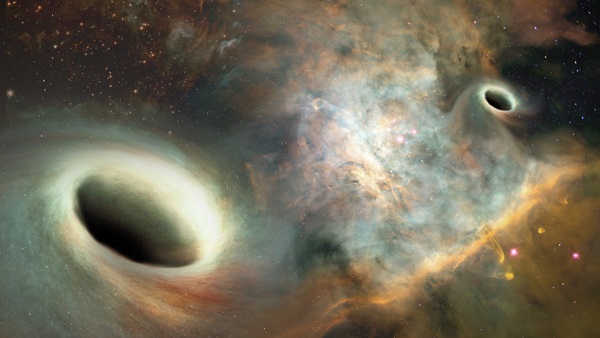Key Takeaways:
The discovery, which appears in the Astrophysical Journal, utilized radio information to determine that the two supermassive black holes are a mere 24 light-years apart and have a combined mass of about 15 billion times the mass of our Sun. It takes them about 30,000 years to complete a single orbit.
The pair of supermassive black holes is located in a giant elliptical galaxy called 0402+379, which was first observed to have two “core” regions in data taken in 2003 and 2005 with the VLBA. The VLBA is part of the Long Baseline Observatory, a radio telescope system utilizing 10 antennas located between Hawaii’s Big Island and St. Croix. Such a long baseline, or large distance between the dishes, allows astronomers to combine the data taken from each to observe objects with significantly greater detail than using one dish alone.
New observations of 0402+379 were taken in 2009 and 2015; when this information was combined with the previous observations, astronomers was finally able to identify the motion of two distinct supermassive black holes. “This is the first pair of black holes to be seen as separate objects that are moving with respect to each other, and thus makes this the first black-hole ‘visual binary,’” said Greg Taylor of the University of New Mexico, one of the study’s authors, in a press release.
Why does this galaxy have two supermassive black holes? The presence of two such objects simply indicates that the galaxy has undergone a merger in the relatively recent cosmic past. When two galaxies combine, each contributes a supermassive black hole to the final product; in time, these two supermassive black holes should also combine, leaving behind a single object. In the case of 0402+379, this just hasn’t happened yet, and likely won’t happen for a few million years yet. That’s how long it will take for the orbits of the supermassive black holes to spiral inward via the loss of energy through gravitational radiation, such as the gravitational waves detected by the Laser Interferometer Gravitational-Wave Observatory (LIGO).
Such pairs of supermassive black holes should actually be quite common, given the fact that galaxy mergers are themselves common events. Mergers are how galaxies grow over cosmic time, morphing from young, active spiral galaxies into old, quiescent ellipticals. “Now that we’ve been able to measure orbital motion in one such pair, we’re encouraged to seek other, similar pairs. We may find others that are easier to study,” explained Karishma Bansal, a graduate student at the University of New Mexico and lead author of the study.
But the confirmation of a pair of supermassive black holes in 0402+379 isn’t the end of astronomers’ interest in this galaxy. “We need to continue observing this galaxy to improve our understanding of the orbit, and of the masses of the black holes,” stressed Taylor. “This pair of black holes offers us our first chance to study how such systems interact.”










